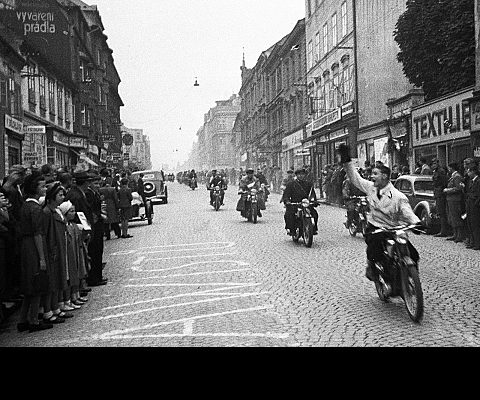Great day for Motorsport in Tábor.
The third national gathering of owners of Jawa motorcycles, combined with the second exhibition of motorsport trophies and gymkhana.
On 27 – 28 August, our historic town hosted an event with no previous parallel here. Motorsport fans from all over the country drove to Tábor to attend the third national gathering of Jawa owners, organized by the Czechoslovak Jawa Owners’ Club.
Combined with this gathering was the second exhibition of motoring trophies, held in the club’s room at the Grand Hotel on Saturday afternoon. At this exhibition were displayed the highest trophy prizes won by Czechoslovak motorsport, at home and abroad. On Sunday 28, at the Tábor Falcons’ Stadium, there was a great exhibition of Gymkhana by the renowned motorcycle acrobatic teams from Jawa clubs of Prague, Týnec on Sázava and Tábor. There was also an exhibition of motorcycle soccer.
The main event of Tábor motorsport festivities was a great parade of all motorcyclists and motorists which proceeded through Tábor before noon on Sunday 28. Participants were greeted by the district commissioner F. Macháček, mayor V. Soumar, and Prague editor B.F. Konopa.
— Newsclip from local paper The Czech South, Tábor, July 10, 1937
Great traffic hustle and bustle at the Grand Hotel crossroads.
On Saturday July 3, there was a great traffic commotion, previously unseen in our parts, and which deserves to be mentioned on these pages. We will yet return to this spot occasionally. For today we want to mention that this three day weekend was a welcome opportunity for thousands of citizens of the capital city of Prague to leave for the country by all available means, mostly by motor vehicles and trains. The main thoroughfares of our town, the main street from the railway station to Žižka town square, also Parkány (the medieval ramparts and bastions), the streets under the castle, the new bridge over the river, the valley of river Lužnice, the embankment of Lake Jordán, and the road to the ruins of Kozí Hrádek were packed by thousands of picnickers and holidaymakers.
The above mentioned crossroads by the Grand Hotel were the main hub of all this activity. At the beginning of the motoring age, several years ago, Husovo Square, previously known as Rieger Square, was not suitable for all this motorised traffic. Now the Square has been divided into sections to accommodate private and public motor vehicles, and truly has become a second “railway station” of our town. This is not an exaggeration, but a true reflection of the present situation.
On Saturday, July 3, it became obvious that detailed police reports are needed to record this massive traffic, the number of vehicles, and also the licence plates of various countries. At the parking lot in front of Grand Hotel one can see the mammoth sized motor coaches, from England, Holland, France, Italy, Austria and Germany. This is no longer a rare sight. Beside these huge vehicles accommodating fifty or more passengers from all parts of our country and abroad, there are also countless numbers of personal autos and motorcycles of all makes.
Although at some hours of the day this crossroads resembles a busy anthill, there are no reports of traffic accidents or serious injuries. Both pedestrians and motorists are well aware of dangers of this place, and obey the directions of the traffic police, whose duties are truly demanding and exhausting. The question arises as to how to devise technical and safety measures to accommodate an ever-increasing flow and speed of traffic, where motor vehicles share the road with rural wagons pulled by horses, wagons full of lumber, and free running dogs, where the road can be entered unintentionally by careless pedestrians, and by well-dressed ladies in high heels and pushing fragile prams with babies in them, etc.
On the whole we are rejoicing in this local and foreign tourist flow, which promises to further increase in the future.
— Newsclip from local paper The Czech South, Tábor, June 11, 1938







